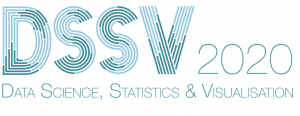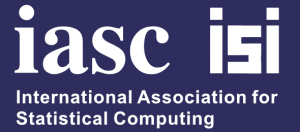Due to COVID-19 this conference will be presented virtually July 29-31, 2020.
Registration is now closed
By registering for this conference you (1) consent to the use of your personal information for the purpose of processing this registration, (2) agree that the conference may include your name, affiliation, and country of residence on the list of attendees, and (3) agree that the organizers may use that information to contact you with updates about this conference and future events.
Participants are expected to adhere to the ISI and Associations Individual Conduct Policy
Description:
Data Science, Statistics & Visualisation (2020) is a virtual conference aimed at bringing together researchers and practitioners interested in the interplay of statistics, computer science, and visualization, and to build bridges between these fields. We shall create a forum to discuss recent progress and emerging ideas in these adjacent disciplines and encourage informal contacts and discussions among all the participants. The conference highlights contributions to practical applications, and in particular those which are linking and integrating these subject areas. Presentations will be oriented towards a very wide scientific audience and will cover topics such as machine learning, the visualization of data, big data infrastructures and analytics, interactive learning, advanced computing, and other important themes.
In order to encourage networking during this virtual conference, it will be possible to set up (virtual) meetings with other participants.
Speakers
Speaker Titles/Abstracts
Posters
(Posters will be presented in 30 minute parallel sessions. Participants can virtually attend the sessions to discuss posters with the presenters.)
Conference Program
Wednesday, July 29, 2020
Virtual – U.S. New York/Eastern Daylight Time
| Time | Description | Speaker | Slides | Videos |
|---|---|---|---|---|
| 8:00-8:50 | Test Audio/Visual | Join the “Click Here to Test Audio/Video Connections” session by navigating to the “Agenda” tab in Whova. (Note: we will not be able to assist with audio/visual issues once the meeting has begun) | ||
| 9:00-9:10 | Opening | David Banks, Duke University and SAMSI | ||
| 9:10-10:00 | Plenary Talk | Chair: David Banks, Duke University and SAMSI
Cynthia Rudin, Duke University |
||
| 10:00-10:10 | Break | |||
| 10:10-11:25 | Parallel Sessions | |||
| Statistical Learning | Org: Patrick Groenen, Erasmus University Chun-houh Chen, Academia Sinica Covariate-adjusted Heatmaps for Visualizing Biological Data via Correlation Decomposition Patrick Groenen, Erasmus University Mikhail Zehlonkin, Erasmus University |
|||
| Statistical Learning | Org: Jason Xu, Duke University Jason Xu, Duke University A Proximal Distance Algorithm for Likelihood-Based Sparse Covariance Estimation Tianxi Li, University of Virginia Aaron J. Molstad, University of Florida |
|||
| Reproducible Computing and Reporting | Org: Jim Harner, West Virginia University Dirk Eddelbuettel, U of Illinois at Urbana-Champaign Reliable Reproducible Research via Containers from the Rocker Project Brian Lee Yung Rowe, Pez.AI Jim Harner, West Virginia University; Chris Grant, Rc2ai; Mark Lilback, Rc2ai |
|||
| 11:25-11:35 | Break | |||
| 11:35-12:50 | Parallel Sessions | |||
| Visualisation | Org: Adalbert Wilhelm, Jacobs University Adalbert Wilhelm, Jacobs University Visual Story Telling of Covid-19: A Case Study Xiaoyue “Zoe” Cheng, University of Nebraska Heike Hofmann, Iowa State University Susan Vanderplas, University of Nebraska-Lincoln |
|||
| Statistical Learning | Org.: Peter Filzmoser, TU Wien Sugnet Lubbe, University of Stellenbosch Comparison of Zero Replacement Strategies for Compositional Data with Large Numbers of Zeros Dorit Hammerling, Colorado School of Mines Matey Neykov, Carnegie Mellon University |
|||
| Data Science | Org.: Ruda Zhang, SAMSI Ruda Zhang, SAMSI Normal-bundle Bootstrap Deborshee Sen, SAMSI Jason Poulos, SAMSI |
|||
| 12:50 | Adjourn |
Thursday, July 30, 2020
Virtual – U.S. New York/Eastern Daylight Time
| Time | Description | Speaker | Slides | Videos |
|---|---|---|---|---|
| 8:00-8:50 | Test Audio/Visual | Join the “Click Here to Test Audio/Video Connections” session by navigating to the “Agenda” tab in Whova. (Note: we will not be able to assist with audio/visual issues once the meeting has begun) | ||
| 9:00-10:15 | Parallel Sessions | |||
| Statistical Learning | Org: Kohei Adachi, Osaka University Kohei Adachi, Osaka University, Japan Principal Component versus Factor Analyses with their Intermediate Procedure in Matrix Decomposition Formulation Inge Koch, University of Western Australia Giuseppe Vinci, Rice University |
|||
| Data Science | Org: John Nardini, SAMSI John Nardini, SAMSI Learning Differential Equation Models for Noisy Biological Data Glen Wright Colopy. Cenduit Xinyi Li, SAMSI |
|||
| 10:15-10:25 | Break | |||
| 10:25-11:15 | Plenary Talk | Chair: Patrick Groenen, Erasmus University
David Dunson, Duke University |
||
| 11:15-11:25 | Break | |||
| 11:25-12:40 | Parallel Sessions | |||
| Statistical Computing | Org: Richard Samworth, University of Cambridge Hao Chen, University of California, Davis Change-point Analysis for Modern Data Yining Chen, London School of Economics Tengyao Wang, University College London |
|||
| Data Science Technology | Org: Jim Harner, West Virginia University Javier Luraschi, RStudio Training ImageNet Using TensorFow and R Soren Harner, LayerJot & Jim Harner, West Virginia University Shih-Hsiung Chou & Phil Turk, Atrium Health |
|||
| New Ideas for Old Problems | Org: Deborshee Sen, SAMSI Pulong Ma, SAMSI Multifidelity Computer Model Emulation with High-Dimensional Output: An Application to Storm Surge Kate Moore, Wake Forest University Wenjia Wang, SAMSI |
|||
| 12:40 | Poster Session | |||
| 1:10 | Adjourn |
Friday, July 31, 2020
Virtual – U.S. New York/Eastern Daylight Time
| Time | Description | Speaker | Slides | Videos |
|---|---|---|---|---|
| 8:00-8:50 | Test Audio/Visual | Join the “Click Here to Test Audio/Video Connections” session by navigating to the “Agenda” tab in Whova. (Note: we will not be able to assist with audio/visual issues once the meeting has begun) | ||
| 9:00-9:50 | Plenary Talk | Chair: Peter Filzmoser, TU Wien
Robert Gramacy, Virginia Polytechnic |
||
| 9:50-10:00 | Break | |||
| 10:00-11:15 | Parallel Sessions | |||
| JDSSV | Orgs: Patrick Groenen, Erasmus University & Stefan Van Aelst, KU Leuven Andreas Alfons, Erasmus University Cellwise and Rowwise Robust Regression with Compositional Covariates Eun-Kyung Lee, Ewha Woman’s University Mu Zhu, University of Waterloo |
|||
| SAS | Orgs: Brett Wujek, SAS Institute Xan Gregg, SAS Institute Understanding Smoothers through Interactive Examples Kelci Miclaus, JMP Lifesciences Guohui Wu, SAS Institute |
|||
| 11:15-11:25 | Break | |||
| 11:25-12:15 | Plenary Talk | Chair: David Banks, Duke University and SAMSI
Ming Yuan, Columbia University |
||
| 12:15-12:25 | Closing |



